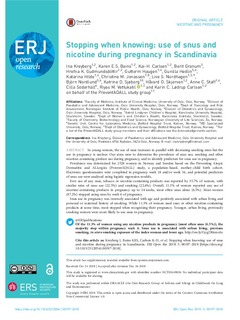| dc.contributor.author | Kreyberg, Ina | |
| dc.contributor.author | Bains, Karen Eline Stensby | |
| dc.contributor.author | Carlsen, Kai-Håkon | |
| dc.contributor.author | Granum, Berit | |
| dc.contributor.author | Gudmundsdóttir, Hrefna Katrín | |
| dc.contributor.author | Haugen, Guttorm | |
| dc.contributor.author | Hedlin, Gunilla | |
| dc.contributor.author | Hilde, Katarina | |
| dc.contributor.author | Jonassen, Christine M | |
| dc.contributor.author | Nordhagen, Live Solveig | |
| dc.contributor.author | Nordlund, Björn | |
| dc.contributor.author | Sjøborg, Katrine Dønvold | |
| dc.contributor.author | Skjerven, Håvard Ove | |
| dc.contributor.author | Staff, Anne Cathrine | |
| dc.contributor.author | Söderhäll, Cilla | |
| dc.contributor.author | Vettukatil, Riyas M. | |
| dc.contributor.author | Carlsen, Karin C. Lødrup | |
| dc.date.accessioned | 2019-07-04T10:36:15Z | |
| dc.date.available | 2019-07-04T10:36:15Z | |
| dc.date.created | 2019-04-30T15:44:30Z | |
| dc.date.issued | 2019 | |
| dc.identifier.citation | ERJ Open Research. 2019, 5 (2), | nb_NO |
| dc.identifier.issn | 2312-0541 | |
| dc.identifier.uri | http://hdl.handle.net/11250/2603385 | |
| dc.description.abstract | In young women, the use of snus increases in parallel with decreasing smoking rates but the use in pregnancy is unclear. Our aims were to determine the prevalence of snus use, smoking and other nicotine-containing product use during pregnancy, and to identify predictors for snus use in pregnancy. Prevalence was determined for 2528 women in Norway and Sweden based on the Preventing Atopic Dermatitis and ALLergies (PreventADALL) study, a population-based, mother–child birth cohort. Electronic questionnaires were completed in pregnancy week 18 and/or week 34, and potential predictors of snus use were analysed using logistic regression models. Ever use of any snus, tobacco or nicotine-containing products was reported by 35.7% of women, with similar rates of snus use (22.5%) and smoking (22.6%). Overall, 11.3% of women reported any use of nicotine-containing products in pregnancy up to 34 weeks, most often snus alone (6.5%). Most women (87.2%) stopped using snus by week 6 of pregnancy. Snus use in pregnancy was inversely associated with age and positively associated with urban living and personal or maternal history of smoking. While 11.3% of women used snus or other nicotine-containing products at some time, most stopped when recognising their pregnancy. Younger, urban living, previously smoking women were more likely to use snus in pregnancy. | nb_NO |
| dc.language.iso | eng | nb_NO |
| dc.publisher | European Respiratory Society | nb_NO |
| dc.subject | women | nb_NO |
| dc.subject | snus | nb_NO |
| dc.subject | nicotine | nb_NO |
| dc.subject | pregnancy | nb_NO |
| dc.subject | Scandinavia | nb_NO |
| dc.subject | kvinner | nb_NO |
| dc.subject | nikotin | nb_NO |
| dc.subject | graviditet | nb_NO |
| dc.title | Stopping when knowing: use of snus and nicotine during pregnancy in Scandinavia | nb_NO |
| dc.type | Journal article | nb_NO |
| dc.type | Peer reviewed | nb_NO |
| dc.description.version | publishedVersion | nb_NO |
| dc.rights.holder | Open Access | nb_NO |
| dc.source.pagenumber | 10 | nb_NO |
| dc.source.volume | 5 | nb_NO |
| dc.source.journal | ERJ Open Research | nb_NO |
| dc.source.issue | 2 | nb_NO |
| dc.identifier.doi | 10.1183/23120541.00197-2018 | |
| dc.identifier.cristin | 1694856 | |
| cristin.unitcode | 251,3,0,0 | |
| cristin.unitname | Fakultet for helsefag | |
| cristin.ispublished | true | |
| cristin.fulltext | original | |
| cristin.qualitycode | 1 | |
